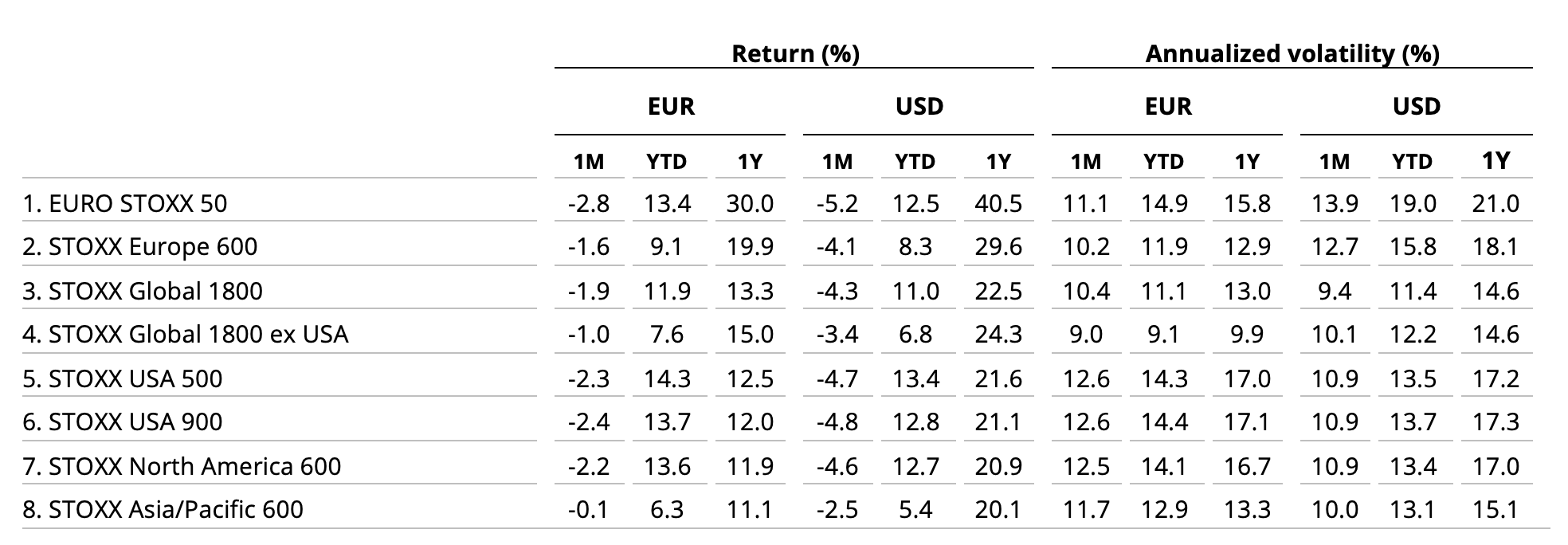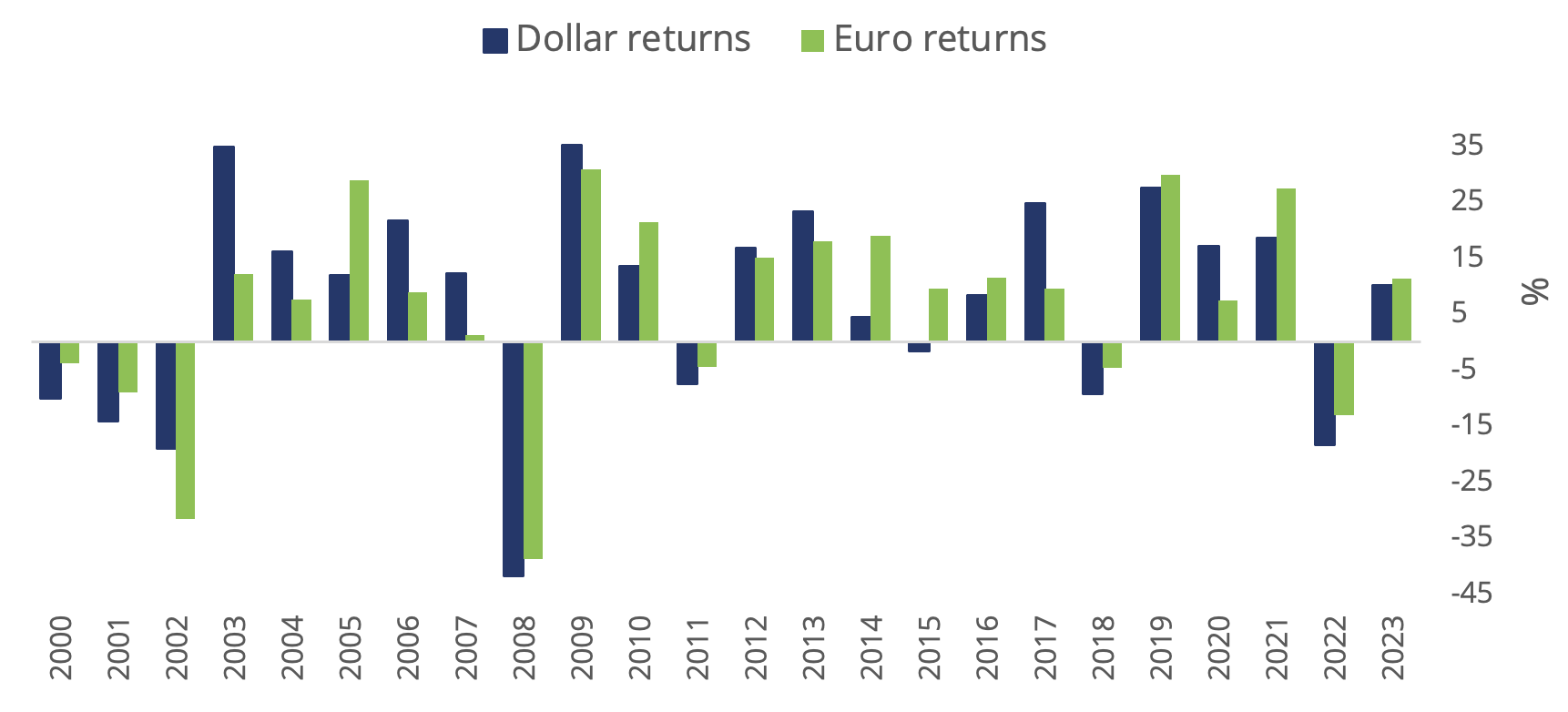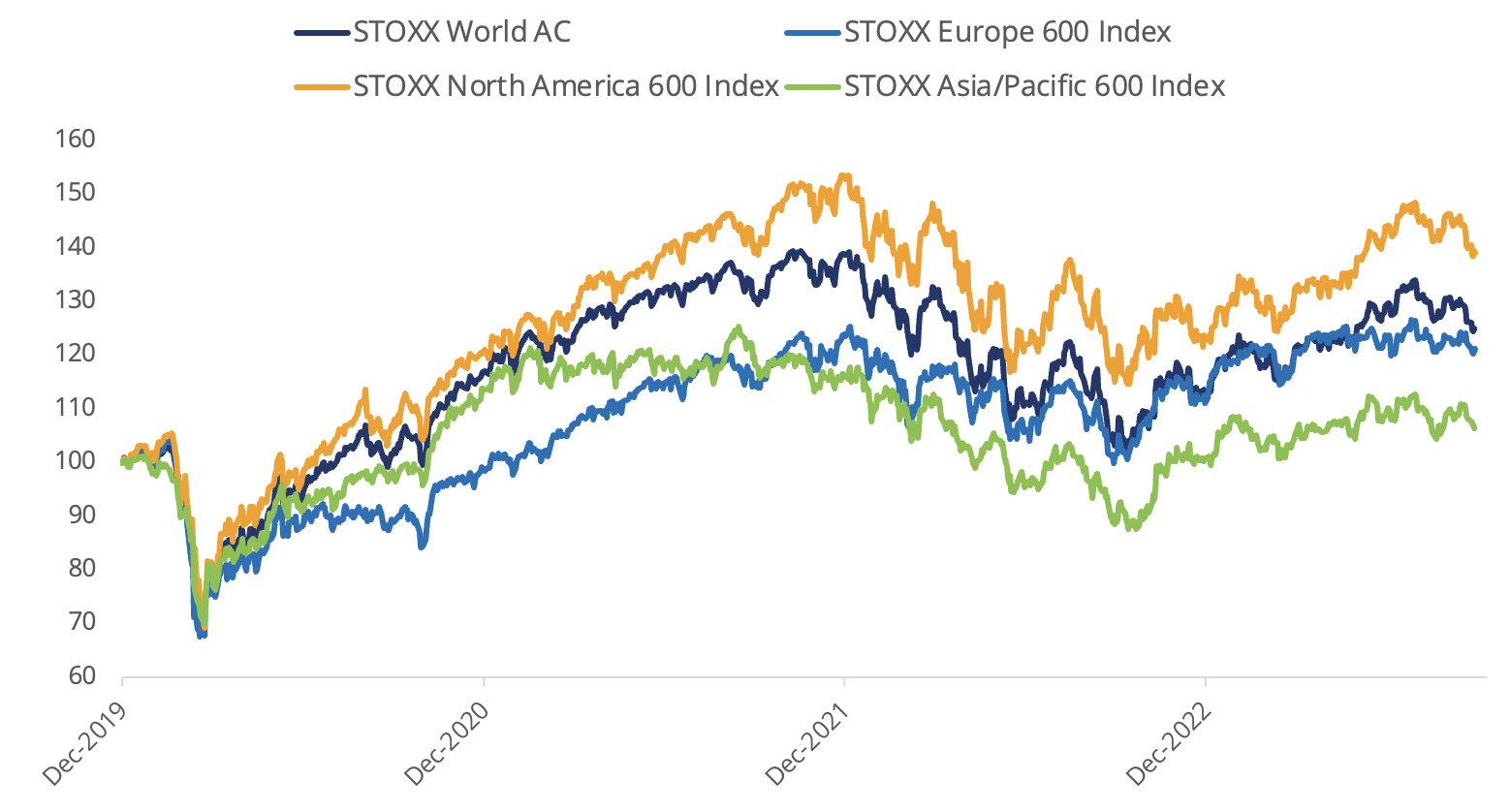
Stocks fell by the most in one year in September amid expectations that interest rates in the US may stay higher for longer than previously expected.
The STOXX® Global 1800 index tumbled 4.3% last month when measured in dollars and including dividends,[1] retreating 3.5% in the third quarter and reducing its 2023 gain to 11%. The benchmark slid 17.9% in 2022, its worst year since 2008, as central banks pressed ahead with higher rates to fight runaway inflation. The index fell 1.9% in euros in September after the greenback rose 2.5% against the common currency. The STOXX® World AC index fell 4% in dollars.
The Eurozone’s EURO STOXX 50® dropped 2.8% in euros in the month on a total-return basis, while the pan-European STOXX® Europe 600 declined 1.6%.[2] The STOXX® North America 600 dropped 4.6% in dollars, while the STOXX® USA 500 fell 4.7% The STOXX® Asia/Pacific 600 lost 2.5% in dollars. The STOXX® Developed World shed 4.2% and the STOXX® Emerging Markets slid 2.3%.
On Sept. 20, the Federal Reserve held interest rates unchanged but projected one more hike is likely this year. The central bank estimated it may cut rates twice in 2024, two fewer than in its June projection, amid stronger-than-forecast economic growth.[3]
Figure 1: STOXX Benchmark indices’ September risk and return

Figure 2: STOXX Equity World indices’ September risk and return

Germany’s DAX® fell 3.5% in the month. MDAX®, which gauges the performance of German mid-caps, retreated 6.3%.
| For a complete review of all indices’ performance last month, visit our September index newsletter |
Figure 3: Total annual % returns for STOXX World AC index

Figure 4: Select STOXX benchmarks’ returns since Jan. 1, 2020

Volatility
The EURO STOXX 50® Volatility (VSTOXX®), which tracks EURO STOXX 50 options prices, rose to 17.5 at the end of last month from 16.1 in August. A higher VSTOXX reading suggests investors are paying up for puts that offer insurance against stock price drops. The VDAX-New®, which measures volatility in German equities, climbed to 16.6 from 14.5 in August.
Oil shares buck trend
Energy stocks were the only one of 20 Supersectors in the STOXX Global 1800 to post a positive return in the month. The STOXX® Global 1800 Energy index gained 2.3%.
All but two of 25 developed markets tracked by STOXX fell in the month when measured in dollars, with Norway and Israel being the exceptions. Thirteen of 20 national developing markets tracked by STOXX declined.
Factor investing
On a global basis, Size showed the worst performance in the month, according to the STOXX Factor indices. The STOXX® Global 1800 Ax Size (-4.9%)[4] was the only factor index to underperform the benchmark. Value was the best-performing style in the month.
Figure 5: STOXX Factor (Global) indices’ September risk and return characteristics

Climate benchmarks
Among climate benchmarks, the STOXX® Global 1800 Paris-Aligned Benchmark (PAB) (-5%) and the STOXX® Global 1800 Climate Transition Benchmark (CTB) (-4.9%) underperformed their benchmark in the month. The PAB and CTB indices follow the requirements outlined by the European Commission’s climate benchmarks regulation.
Among the STOXX Low Carbon indices, the EURO STOXX 50® Low Carbon (-2.6%) outperformed the EURO STOXX 50 by 20 basis points in September. Elsewhere, the STOXX® Global Climate Change Leaders (-4%), which selects corporate leaders that are publicly committed to reducing their carbon footprint, outperformed the STOXX Global 1800 by 29 basis points.
Sustainability indices
The STOXX® Global 1800 ESG-X index slid 4.4% in the month. The STOXX® ESG-X indices are versions of traditional, market capitalization-weighted benchmarks that observe standard responsible exclusions.
Within indices that combine exclusions and ESG best-in-class integration, the EURO STOXX 50® ESG index fell 1.8%, outperforming its benchmark by 1 percentage point. Germany’s DAX® 50 ESG index (-2.9%), which excludes companies involved in controversial activities and integrates ESG scoring into stock selection, dropped less than the benchmark DAX.
Among other STOXX sustainability families, the STOXX® Global 1800 ESG Broad Market fell 4.4% in the month. The STOXX ESG Broad Market indices apply a set of compliance, product involvement and ESG performance exclusionary screens on a starting benchmark universe until only the 80% top ESG-rated constituents remain.
The STOXX® Global 1800 ESG Target lost 4.3%, the EURO STOXX® ESG Target fell 3.2% and the DAX® ESG Target dropped 2.4%. The STOXX and DAX ESG Target indices seek to significantly improve the benchmark portfolio’s ESG profile while mirroring its returns as closely as possible. Through a series of constraints, the indices implement an optimization process to maximize the overall ESG score of the portfolio while limiting the tracking error to the benchmark.
The STOXX® Global 1800 SRI retreated 4.9%. The STOXX SRI indices apply a rigorous set of carbon emission intensity, compliance and involvement screens, and track the best ESG performers in each industry group within a selection of STOXX benchmarks.
Finally, the DAX® ESG Screened fell 3% in the month. The index reflects the composition of the DAX benchmark minus companies that fail to pass norms-based and controversial weapons screenings, meet minimum ESG ratings or are involved in certain business activities considered undesirable from a responsible investing perspective.
Thematic indices
Among 33 STOXX® Thematic indices, only six outperformed the benchmark STOXX Global 1800 last month.
Dividend strategies reduced their 2023 underperformance. The STOXX® Global Maximum Dividend 40 (-1.9%) selects only the highest-dividend-yielding stocks. The STOXX® Global Select Dividend 100 (-1.8%) tracks companies with sizeable dividends but also applies a quality filter such as a history of stable payments.
Minimum variance
Minimum variance strategies had mixed relative performances last month, with those in Europe underperforming the benchmark and those in the US outperforming. The STOXX® Global 1800 Minimum Variance fell 2.4% and the STOXX® Global 1800 Minimum Variance Unconstrained lost 2.8%.
The STOXX Minimum Variance Indices come in two versions. A constrained version has similar exposure to its market-capitalization-weighted benchmark but with lower risk. The unconstrained version, on the other hand, has more freedom to fulfill its minimum variance mandate within the same universe of stocks.
[1] All results are total returns before taxes unless specified.
[2] Throughout the article, all European indices are quoted in euros, while global, North America, US, Japan and Asia/Pacific indices are in dollars.
[3] For more, see CNBC, “Fed declines to hike, but points to rates staying higher for longer,” Sept. 20, 2023.



